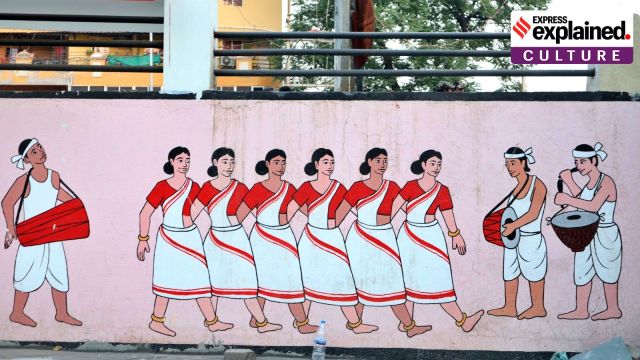In celebration of tribal festival Sarhul, link to communities’ history, politics
Sarhul, literally “worship of the Sal tree”, is among the most revered Adivasi festivals. It is rooted in nature worship and celebrates the symbolic union of the Sun and the Earth.
 Preparations on at the Siram Toli Sarna Sthal in Ranchi. (Express photo by Shubham Tigga)
Preparations on at the Siram Toli Sarna Sthal in Ranchi. (Express photo by Shubham Tigga)Adivasis in Jharkhand and the larger Chhotanagpur region will welcome the new year and the spring season with the Sarhul festival on Tuesday.
Nature worship
Sal trees (Shorea robusta) are venerated in Adivasi tradition. They are seen as the abode of Sarna Maa, the deity protecting the village from inclement natural forces.
Sarhul, literally “worship of the Sal tree”, is among the most revered Adivasi festivals. It is rooted in nature worship and celebrates the symbolic union of the Sun and the Earth.
A male priest from the village (pahan) plays the role of the Sun, while his wife (pahen) becomes the Earth. Priest Bandhan Tigga told The Indian Express that this union is key to all life on Earth, which depends on the coming together of the Sun’s rays and the soil (Earth).
Sarhul can thus be seen as a celebration of the cycle of life itself. Only after the rituals are completed do Adivasi folk begin ploughing their fields, sowing their crop, or entering the forest to gather produce.
Three-day festival
The main rituals happen on day two of the three-day festival at Sarna Sthals. These communally protected “sacred groves” can be found near villages across Chhotanagpur, which includes Jharkhand, parts of Chhattisgarh, Odisha, and Bihar.
In the lead up, homes and Sarna Sthals are lined with triangular, red and white Sarna flags. On the first day of Sarhul, the village’s pahan, who observes a rigorous fast, fetches water for the ceremonies, houses and Sarna Sthals are cleaned, and Sal flowers gathered for rituals.
On the next day, the main rituals take place at the Sarna Sthal. The deity is presented with Sal flowers, and a rooster is sacrificed. Villagers seek prosperity, safety, and a good harvest. Holy water is then sprinkled across the village, with performances of traditional songs and dances such as Jadur, Gena and Por Jadur. Later, young men head to nearby ponds and rivers and participate in ceremonial fishing and crab-catching to gather food for the ceremonial feast.
The final day is marked by a grand community feast, in which people share handia (rice beer) and enjoy a variety of delicacies. The festival ends with the pahan’s blessings and the villagers praying.
Chhotanagpur & beyond
Sarhul has been celebrated by tribes such as the Oraon, Munda, Santal, Khadia, and Ho, with unique names for the festival and particular ways of celebrations.
Anthropologist Sarat Chandra Roy, in his seminal work Oraon Religion and Customs (1928), observed that over time, Sarhul evolved from being a hunting-centred tradition to one that revolves around agricultural processes. This, he said, reflected the evolving lifestyle of Adivasis in Chhotanagpur.
During the 19th and early 20th centuries, when tribes such as the Munda, Oraon, and Santal were sent to faraway places as indentured labour, Sarhul traveled with them. Today, the festival is celebrated in locations ranging from the tea gardens of Assam to the Andaman and Nicobar Islands, Nepal, Bangladesh, and Bhutan.
Evolution of Sarhul
In the 1960s, Adivasi leader Baba Karthik Oraon, who advocated for social justice and the preservation of tribal culture, began a Sarhul procession from Hatma to the Siram Toli Sarna Sthal in Ranchi.
In the past 60 years, festive processions have emerged as a crucial part of Sarhul, with the Siram Toli site becoming a major point of convergence for processions. This has also made Sarhul increasingly political, and an occasion to assert the Adivasi identity.
It also comes at a time when some tribes have sought to claim their distinctiveness from Hinduism. Adivasis following the Sarna faith have demanded the inclusion of a Sarna religion column in the caste census of India in the last 20 years. Several Adivasi groups affiliated with the RSS have, however, argued that Adivasis are part of Hinduism.
Geeta Shree Oraon, national women’s president of the Akhil Bharatiya Adivasi Vikas Parishad, said the slogan ‘Sarna-Sanatani Ek Hai’ (sarna and sanatanis are one) was once given by Hindu groups to emphasise common identities. She said the slogan “gradually embedded the idea that Adivasis are Hindus in people’s minds.” “Later, in 2017, the RSS chief visited Jharkhand and stated that Adivasis are part of Hinduism, questioning the need for a separate identity column. These are the tactics they use to Hinduise the Sarna religion,” she added.
More Explained
Must Read
EXPRESS OPINION
Apr 02: Latest News
- 01
- 02
- 03
- 04
- 05




























